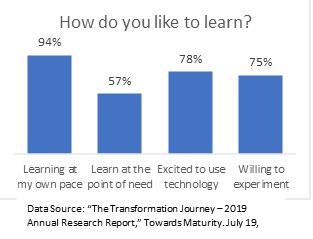
You probably know that SumTotal has a direct connection to LinkedIn Learning (LIL) to provide quality learning content to your workforce. What you may not know is how much it can do for your organization.
Recent improvements in SumTotal’s LinkedIn integration make the platform a complete tool for self-directed learning:
- Simpler, automated Single Sign-On (SSO) eliminated the need for a separate login; the two technologies work together as one.
- LinkedIn learning assets import as tin can.xml files and launch as xAPI courses, giving you and your learners more visibility into learning behaviors.
- In soon-to-be-released SumTotal 20.1, users will access LinkedIn Learning assets on their mobile devices.
Learning Resources on Demand
LinkedIn Learning puts a wealth of learning at your users’ fingertips, designed for the way modern learners of all ages want to learn. They can access over 15,000 online business, tech, and design courses and video tutorials taught by real-world professionals. Users can explore topics in-depth, but they can also solve an immediate need from dealing with a difficult manager to deciphering a programming puzzle in Python.
LIL isn’t the place to go if you want to earn a certification or degree, but it can be useful for those who want to explore a career path to decide if they will invest in it. It is ideal for those who wish to gain a new skill without credentials beyond a certificate of completion or to learn how to handle a situation in the flow of work.
The most popular learning topics are software development, leadership and management, business software and tools, and data science. The most popular courses (as of today) are “Organizational Culture,” “Body Language for Women,” and “Becoming Head of Sales: Developing Your Playbook.”
What makes this vast content library so useful is that it is designed for its audience —nearly 660+ million users – mostly professionals who want to become more productive and successful.
How Workers Want to Learn
Towards Maturity’s 2019 Annual Research Report showed that workers want to learn at their own pace and at the point of need. They are excited about using new technology, and they are willing to experiment in learning.

The partnership between LinkedIn and SumTotal meets your learners right where they want to be.
The Missing Pieces
However, that’s only half of what you need to create a culture of learning. If you only enable LinkedIn Learning, you only reach that portion of your workforce that has already bought into the concept of self-directed lifelong learning.
The two missing pieces are expectations and rewards.
Learning Expectations
If your company is like most of today, you anticipate that jobs will evolve rapidly, or you may already deal with the changes. If you speak to changing opportunities and back it up with development resources, the underlying message is that people are expected to learn as their jobs evolve.
Senior leaders will need to speak to self-development and engage in it themselves to set the example, and they must hold their managers accountable for developing their people. And, of course, self-development and team development should be performance expectations.
Learning Rewards
The best reward for learning is the opportunity to use new skills on the job. When you reward self-development, your most talented people will be more willing to stay with you.
The message is clear when you look internally for talent: those who develop themselves will be rewarded.
A developing concept is the internal gig economy, where you recruit for skills inside your organization for projects, special initiatives, and career changes. When you share talent across the organization, you will both increase capacity and keep people who may have been considering leaving for external opportunities.
Most intriguing in the Towards Maturity report is that workers expressed less resistance to developing a learning culture than the L&D teams that support them. Fifty-four percent of learning pros believe learning is not a management priority. Three in five said individuals lack skills to manage their own learning. The report authors caution that L&D must be cautious to avoid continuing the cycle of negativity.
Learning how to learn is not often taught in schools or organizations. Perhaps L&D’s primary task is to teach them, beginning on Day One of employment.
Pixentia is a full-service technology company dedicated to helping clients solve business problems, improve the capability of their people, and achieve better results.

